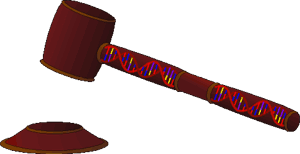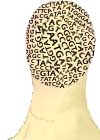 |
|
||||||||||
|
|
|||||||||||
DNA Fingerprinting
In 1985 Ronald Cotton was imprisoned for the rape of Jennifer Thompson. She had identified him from pictures and a line-up as the assailant. Circumstantial evidence stacked up against Cotton making it quite clear that Cotton was guilty. He was imprisoned with no flaw in the judicial system to speak of, except one…he was innocent. After 10 years of imprisonment, biochemical technology allowed the comparison of Cotton’s DNA to that of the rapist’s semen, proving his innocence beyond a shadow of a doubt. The same evidence was then used to rightfully convict Robert Poole, a convict who had mentioned the rape to fellow inmates.
The methods for obtaining and comparing the genetic samples of evidence and suspects were originally developed to determine the compatibility of Human Leukocyte Antigens (HLA) in individuals for organ and bone marrow transplants. These antigens are highly specific to an individual and are used by the body’s immune system to determine self from non-self. If a transplant is made without first comparing the compatibility of these antigens, there is a very high likelihood that the donated tissue will be rejected and attacked by the recipient’s immune system. The high amount of specificity allows the regions of DNA encoding for the antigens to be extremely useful in identifying one out of several million people. The commonly used methods for isolating and comparing genetic sequences include polymerase chain reactions (PCR) and restriction fragment length polymorphisms (RFLP).
The process for PCR is commonly used to analyze genetic information in many genetic investigations. Even a few molecules of DNA can be amplified to produce large quantities. This property makes PCR ideal for analyzing small samples of DNA. The laboratory procedure involves a cycle of denaturing, annealing, and extending DNA. An increase of temperature triggers denaturing. The hydrogen bonds break between the double stranded helix and they separate. In the process of annealing, the temperature is lowered, which enables primers to attach. Primers are segments of DNA having a free OH group on the 3’ carbon of a nucleotide. These primers align with a very specific sequence of amino acids. After the temperature is increased slightly, a DNA polymerase is able to attach nucleotides to the 3’ carbon of the primer and extend the complementary strand. Each temperature-regulated cycle greatly increases the amount of DNA present, which makes more available for amplification in the next cycle. For analysis, the PCR product is heated once again and washed over a typing strip. These typing strips are composed of different variations of the alleles amplified during the PCR process. HLA DQa was the first type of strip to be used for forensic analysis. The strip is made by fixing Sequence-Specific Oligonucleotide (SSO) probes to a support. The HLA DQa strip tests for the presence of six different kinds of DQa alleles. There are four main types of alleles fixed to the strip. The 1 allele is then subtyped into 1.1,1.2 and 1.3. The SSOs are placed in nine dots along the strip. The first four probes test for alleles 1-4 respectively. The fifth dot is a control that will attach to any DQa type. Any dot lighter than the control probe is considered invalid. The sixth probe is for the subtype 1.1. The seventh probe will indicate a positive response for 1.2, 1.3 or 4. The eighth detects the presence of subtype 1.3. The last probe will respond to every allele except the 1.3 subtype. These SSO probes grab on to complementary PCR-amplified fragments as they are washed over the strip. The strips are then washed to remove any unattached fragments of DNA. The detection of the DNA on the probe goes back to the primers used during PCR. All of these primers were tagged with biotin. The presence of biotin allows streptavidin to bond to the fragments after they attach to the strip. The streptavidin is chemically linked to horseradish peroxidase (HRP). HRP emits the color blue when in the presence of hydrogen peroxide and tetra-methyl-benzidine (TMB). The resulting strip can then be viewed for analysis. Modern forensics uses an HLA DQA1 testing strip. The advantage of the new strip is the detection of the allele 4 subtypes as well as the allele 1 subtypes.
RFLP comparisons are much more specific tests, but require DNA samples of very high quality to work effectively. The procedures are also much more labor-intensive than PCR. First a restriction endonuclease is used to cut the DNA into millions of fragments. The restriction endonuclease is able to cut a strand when it comes across a specific sequence of nucleotides. These fragments are separated by gel electrophoresis based on their relative sizes. Smaller fragments have less drag in the gel and are carried further by the current. NaOH is then added to the gel to alter the pH and break the duplex DNA molecules into singular strands. The fragments are transferred to a nylon membrane in a process called Southern Blotting. In this procedure the nylon membrane is placed on top of the gel. Absorptive material is then placed on top of the membrane, pulling the gel through the nylon into the material. The DNA is carried in the gel medium to the nylon membrane where it is fixed to the sheet. The membrane is baked to more tightly attach the DNA fragments. To ensure no other DNA molecules can attach to the sheet, protein or detergent is added, which blocks all of the vacant spots where a DNA fragment could attach. Now the only way a DNA molecule can bond to the sheet is if it is complementary to the single stranded DNA already fixed to it. Probe fragments of specific genes are then made radioactive and washed over the membrane. If the complementary segment is present on the membrane, the probe will attach. After washing away the unattached probes, X-ray film or a phosphorimager can then be used to detect the presence of an attached probe and thus the presence of the gene in the sample. The variability in the types and sizes of probes allow RFLP to reveal a large amount of very specific information. The membrane can be cleaned of any probe and retested with another providing an even larger amount of data.
As the O.J. Simpson trial best exemplified, one must not be too quick to judge DNA fingerprinting as a fail proof method of determining truth. In this trial both PCR and RFLP methods of analysis were applied to 45 bloodstains. At the scene of the murder, 8 drops of blood along the walkway and back gate were found to be O.J. Simpson’s. Seven bloodstains in O.J.’s Bronco were found to be Nichole Brown and/or Ronald Goldman’s. Three drops of Nichole Brown’s blood were found on O.J. Simpson’s socks and 11 bloodstains found on the Rockingham glove contained the victims’ DNA. In spite of all of this biochemical data indicating O.J. Simpson as the murderer, the defense was able to convince the jury that genetic evidence is only as reliable as those who are in charge of the tests and a verdict of not guilty was pronounced. Nevertheless, today’s courts are filling up with appeals on the grounds of new reliable genetic evidence. Many innocent men and women can now be justly returned to their freedom. The number of overturned rulings has even fueled the movement against the death penalty as people repeatedly witness just how many false convictions there are. Cases like those of Ronald Cotton are showing that even an eyewitness many not be as reliable as the witness provided in the genetic fabric of life itself. The maximum potential for this technology is far from being attained. The days may be approaching when a hair follicle dropped into a computer produces the picture of the guilty party in seconds. Why bother even sending police out to look for them? If that hair follicle has the criminal’s antigen information on it, isn’t it possible to produce a virus that targets that individual's unique HLA profile? Then release the virus and wait at the hospital or morgue for the right symptoms. It sounds drastic, but it may be possible… |
 |
 |
Copyright 2006, John Wiley & Sons Publishers, Inc. |
 |
 |
 Perhaps one of the most disquieting elements in our justice system today is the thought of wrongfully convicting or even sentencing to death the innocent. Biochemistry, in the development of DNA forensics, provides justice a more decisive scale in weighing the innocence or guilt of an individual.
Perhaps one of the most disquieting elements in our justice system today is the thought of wrongfully convicting or even sentencing to death the innocent. Biochemistry, in the development of DNA forensics, provides justice a more decisive scale in weighing the innocence or guilt of an individual. Since the early 1980’s DNA "fingerprints" have been used to convict or release possible suspects involved in many crimes. The use of these fingerprints by the FBI’s Forensic Science Systems Unit to form the national DNA registry called, Combined DNA Index System (CODIS), is perhaps one of the greatest assets to criminal investigators to date. It is the goal of the FBI to have the Index operating much like the Automated Fingerprint Index System (AFIS). The Standardization Project has insured that all of the genetic information collected across the United States is in a comparable format. All states have authorized the submission of DNA from violent criminals and sexual offenders to CODIS. Almost any type of biological evidence found at a crime scene may be compared to a suspect, including: blood, semen, saliva, bone, tissue, teeth, and even hair follicles.
Since the early 1980’s DNA "fingerprints" have been used to convict or release possible suspects involved in many crimes. The use of these fingerprints by the FBI’s Forensic Science Systems Unit to form the national DNA registry called, Combined DNA Index System (CODIS), is perhaps one of the greatest assets to criminal investigators to date. It is the goal of the FBI to have the Index operating much like the Automated Fingerprint Index System (AFIS). The Standardization Project has insured that all of the genetic information collected across the United States is in a comparable format. All states have authorized the submission of DNA from violent criminals and sexual offenders to CODIS. Almost any type of biological evidence found at a crime scene may be compared to a suspect, including: blood, semen, saliva, bone, tissue, teeth, and even hair follicles.